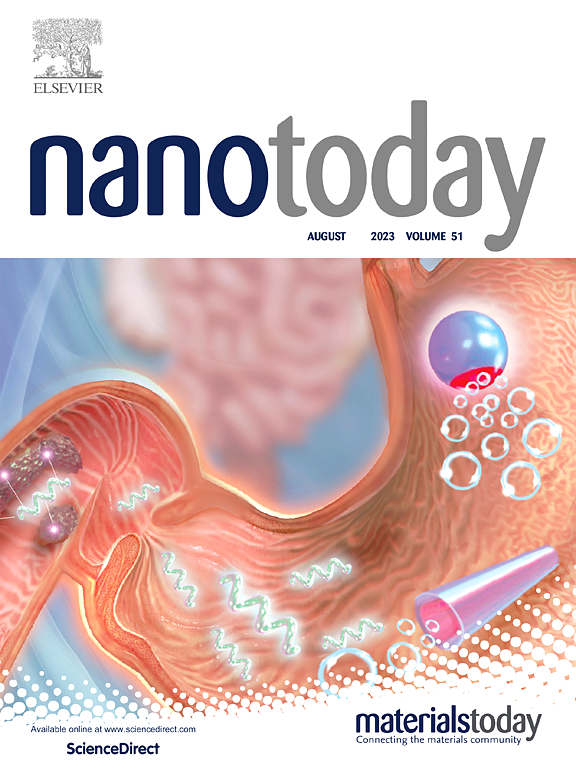利用聚单宁酸纳米球对侵袭性TNBC细胞的氧化还原驱动机制调控
IF 10.9
1区 材料科学
Q1 CHEMISTRY, MULTIDISCIPLINARY
引用次数: 0
摘要
聚单宁酸(pTA)纳米球由天然单宁酸分子组装而成,具有很强的细胞内抗氧化活性,可有效调节三阴性乳腺癌(TNBC)细胞的侵袭行为。作为氧化还原活性纳米结构,pTA纳米球抑制增殖并诱导机械调节变化,包括核形态改变、细胞骨架解体和细胞极性减弱。具体来说,pTA治疗导致MT1-MMP从侵袭前沿到核周区域的空间错定位,破坏其与f -肌动蛋白的共定位,降低其基质降解能力。高分辨率STED和TEM成像显示静脉蛋白网络崩溃和线粒体沿微管重新分布。代谢分析显示氧化磷酸化相关的ATP产生明显下降。尽管存在这些功能破坏,但切割后的caspase-3仍然无法检测到,这表明caspase-3处于非凋亡、细胞抑制状态,并伴有自噬和氧化还原信号补偿。这些发现表明,pTA纳米球在TNBC细胞中发挥氧化还原驱动的机制调节作用,在不诱导细胞死亡的情况下限制了它们的侵袭潜力,并突出了它们作为手术后或辅助控制转移进展的非致死性纳米治疗方法的前景。本文章由计算机程序翻译,如有差异,请以英文原文为准。
Redox-driven mechanoregulation of invasive TNBC cells using poly(tannic acid) nanospheres
Poly(tannic acid) (pTA) nanospheres, assembled from natural tannic acid molecules, exhibit strong intracellular antioxidant activity and effectively modulate the invasive behaviour of triple-negative breast cancer (TNBC) cells. Acting as redox-active nanostructures, pTA nanospheres suppress proliferation and induce mechanoregulatory changes, including altered nuclear morphology, cytoskeletal disassembly, and diminished cell polarity. Specifically, pTA treatment causes spatial mislocalization of MT1-MMP from the invasive front to the perinuclear zone, disrupting its colocalization with F-actin and reducing its matrix-degrading capacity. High-resolution STED and TEM imaging reveal vimentin network collapse and mitochondrial redistribution along microtubules. Metabolic profiling shows a marked decline in oxidative phosphorylation-linked ATP production. Despite these functional disruptions, cleaved caspase-3 remains undetectable, indicating a non-apoptotic, cytostatic state accompanied by autophagy and redox signalling compensation. These findings demonstrate that pTA nanospheres exert redox-driven mechanoregulation in TNBC cells, limiting their invasive potential without inducing cell death, and highlight their promise as a non-lethal nanotherapeutics approach for post-surgical or adjuvant control of metastatic progression.
求助全文
通过发布文献求助,成功后即可免费获取论文全文。
去求助
来源期刊

Nano Today
工程技术-材料科学:综合
CiteScore
21.50
自引率
3.40%
发文量
305
审稿时长
40 days
期刊介绍:
Nano Today is a journal dedicated to publishing influential and innovative work in the field of nanoscience and technology. It covers a wide range of subject areas including biomaterials, materials chemistry, materials science, chemistry, bioengineering, biochemistry, genetics and molecular biology, engineering, and nanotechnology. The journal considers articles that inform readers about the latest research, breakthroughs, and topical issues in these fields. It provides comprehensive coverage through a mixture of peer-reviewed articles, research news, and information on key developments. Nano Today is abstracted and indexed in Science Citation Index, Ei Compendex, Embase, Scopus, and INSPEC.
 求助内容:
求助内容: 应助结果提醒方式:
应助结果提醒方式:


